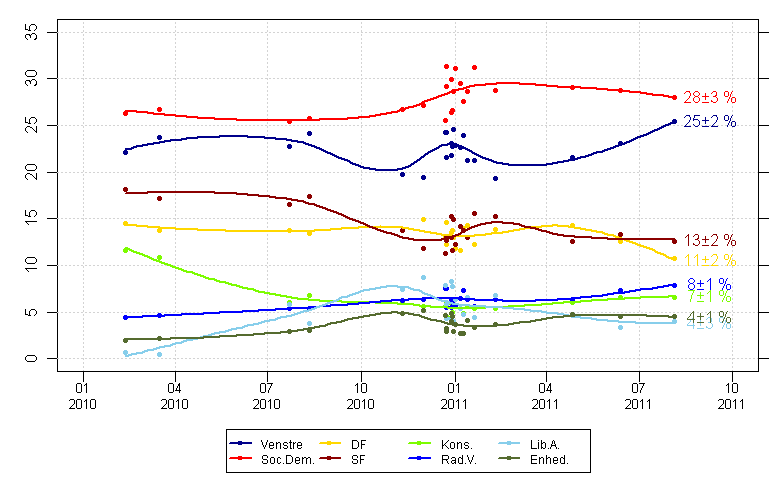rm(list=ls())
#Parameters
party.names <- c("Venstre","Soc.Dem.","DFP","SF","Kons.","Rad.V.","Lib.A.","Enhed.","KD")
parties.to.plot <- party.names[1:8]
party.cols <- c("darkblue","red","gold","darkred","lawngreen","blue","darkolivegreen")
ylims <- c(0,35)
xlims <- c(ISOdate(2010,1,15),ISOdate(2011,10,15))
ticks <- ISOdate(rep(c(2010,2011),each=4),rep(c(1,4,7,10),times=2),15)
#Load the complete HTML file into memory
html <- readLines(url("http://en.wikipedia.org/wiki/Danish_parliamentary_election,_2011"),encoding="UTF-8")
closeAllConnections()
#Extract the opinion poll data table
tbl.no <- 6
tbl <- html[][tbl.no]):(grep("</table.*",html)[tbl.no])]
#Now split it into the rows, based on the <tr> tag
tbl.rows <- list()
open.tr <- grep("<tr",tbl)
close.tr <- grep("</tr",tbl)
for(i in 1:length(open.tr)) tbl.rows[[i]] <- tbl[][i]:close.tr[i]
#Throwout items that are headers or extra info
tbl.rows <- tbl.rows[sapply(tbl.rows,function(x) length(grep("<td",x)))>1]
#Now extract the data
survey.dat <- lapply(tbl.rows,function(x) {
#Start by only considering where we have <td> tags
td.tags <- x[grep("<td",x)]
#Polling data appears in columns 3-10
dat <- td.tags[4:12]
#Now strip the data and covert to numeric format
dat <- gsub("<td>|</td>","",dat)
dat <- gsub("<b>|</b>","",dat)
dat <- gsub("%","",dat)
dat <- gsub("-","0",dat)
dat <- as.numeric(dat)
dat <- ifelse(is.na(dat),0,dat)
names(dat) <- party.names
#Getting the date strings is a little harder. Start by tidying up the dates
date.str <- td.tags[2] #Dates are in the second column
date.str <- gsub("<td>|</td>","",date.str) #Throw out any tags
#And finally the survey time
survey.time <- as.POSIXct(strptime(date.str,format="%Y-%m-%d"))
#Get the name of the survey company too
survey.comp <- td.tags[1]
survey.comp <- gsub("<sup.*</sup>","",survey.comp)
survey.comp <- gsub("<td>|</td>","",survey.comp)
survey.comp <- gsub("<U+2013>","-",survey.comp,fixed=TRUE)
survey.comp <- gsub("(?U)<.*>","",survey.comp,perl=TRUE)
#And now return results
return(data.frame(Company=survey.comp,Date=survey.time,date.str,t(dat)))
})
#Combine results
surveys <- do.call(rbind,survey.dat)
#Subset data to only plot selected parties in time window
polls <- surveys[,c("Company","Date",parties.to.plot)]
polls <- subset(polls,!is.na(polls$Date) )
polls <- subset(polls,polls$Date>=min(xlims) )
polls <- polls[order(polls$Date),]
polls$date.num <- as.double(polls$Date)
#Setup plot
png("DK_opinion_polls_2011_election.png",width=778,height=487,pointsize=16)
par(mar=c(3,4,1,1),oma=c(3,0,0,0))
matplot(polls$date.num,polls[,parties.to.plot],pch=NA,xlim=xlims,ylab="Party support (%)",xlab="",
col=party.cols,xaxt="n",ylim=ylims)
abline(h=seq(0,95,by=5),col="lightgrey",lty=3)
abline(v=as.double(ticks),col="lightgrey",lty=3)
axis(1,at=as.double(ticks),labels=format(ticks,format="%b\n%Y"),cex.axis=0.8)
axis(4,at=axTicks(4),labels=rep("",length(axTicks(4))))
#Now calculate the loess smoothers and add the confidence interval
smoothed <- list()
predict.x <- seq(min(polls$date.num),max(polls$date.num),length.out=100)
for(i in 1:length(parties.to.plot)) {
smoother <- loess(polls[][i] ~ polls[,"date.num"],span=0.75)
smoothed[[i]] <- predict(smoother,newdata=predict.x,se=TRUE)
# polygon(c(predict.x,rev(predict.x)),
# c(smoothed[[i]]$fit+smoothed[[i]]$se.fit*1.96,rev(smoothed[[i]]$fit-smoothed[[i]]$se.fit*1.96)),
# col=rgb(0.5,0.5,0.5,0.5),border=NA)
}
names(smoothed) <- parties.to.plot
#Then add the data points
matpoints(polls$date.num,polls[,parties.to.plot],pch=20,col=party.cols)
#And finally the smoothers themselves
for(i in 1:length(parties.to.plot)) {
lines(predict.x,smoothed[[i]]$fit,col=party.cols[i],lwd=2)
}
legend(grconvertX(0.5,"npc"),grconvertY(0,"nfc"),legend=parties.to.plot,col=party.cols,
pch=20,bg="white",lwd=2,ncol=ceiling(length(parties.to.plot)/2),cex=0.75,xpd=NA,xjust=0.5)
#Add best estimates
for(i in 1:length(smoothed)) {
lbl <- sprintf("%2.0f ± %1.0f",round(rev(smoothed[[i]]$fit)[1],0),round(1.96*rev(smoothed[[i]]$se.fit)[1],0))
text(rev(polls$date.num)[1],rev(smoothed[[i]]$fit)[1],labels=lbl,pos=4,col=party.cols[i])
}
dev.off()







